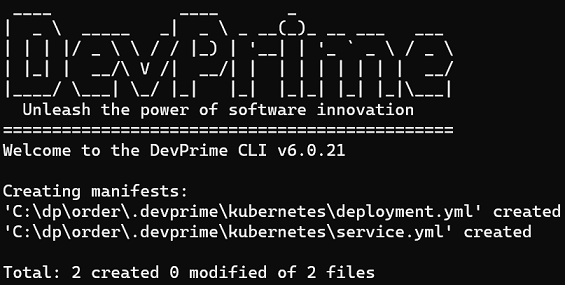Kubernetes
Deploying and running a Devprime microservice on kubernetes
To publish a container image to Kubernetes, you must have a public image in docker Hub or in repositories such as Azure Container Registry (ACR), Amazon Elastic Container Registry, Google Container Registry, Oracle Cloud Infrastructure Container Registry, and others.
We recommend reading the docker documentation that demonstrates how to build a docker image and publish to a repository.
**Creating a “deployment.yml” deployment file
The standard procedure in Kubernetes is to create a deployment file as “deployment.yml” and include the content below by modifying the image configuration. The “env” parameters that represent the environment variables.
1
2
3
4
5
6
7
8
9
10
11
12
13
14
15
16
17
18
19
20
21
22
23
24
25
26
27
28
29
30
31
32
33
34
35
36
37
38
39
40
41
42
43
44
45
46
47
48
49
50
51
52
53
54
55
56
57
58
59
60
61
62
63
64
|
apiVersion : apps/v1
kind: Deployment
metadata:
name: ms-order
spec:
replicas: 1
selector:
matchLabels:
app: ms-order
template:
metadata:
labels:
app: ms-order
spec:
containers:
- name: ms-order
image: ms-order:latest
imagePullPolicy: Always
readinessProbe: # Disponivel para receber trafego
httpGet:
path: /healthcheck #/healthz # Endpoint que a sonda de prontidão deve verificar
port: 80 # Porta em que o contêiner está escutando
initialDelaySeconds: 30 # Tempo de espera inicial antes de iniciar as verificações
periodSeconds: 10 # Frequência de verificação da prontidão
timeoutSeconds: 1
successThreshold: 1
failureThreshold: 3
livenessProbe: # Disponivel para receber trafego
httpGet:
path: /healthcheck #/healthz # Endpoint que a sonda de prontidão deve verificar
port: 80 # Porta em que o contêiner está escutando
initialDelaySeconds: 40 # Tempo de espera inicial antes de iniciar as verificações
periodSeconds: 10 # Frequência de verificação da prontidão
timeoutSeconds: 1 # How long to wait for a response
successThreshold: 1 # Criterio para considerar sucesso
failureThreshold: 3 # Number of failures to tolerate before restarting
terminationGracePeriodSeconds: 90 # Override pod-level termination
ports:
- containerPort: 80
env:
- name: Devprime_app
value: "license=Put your license|||debug=false|||debugstate=false|||debugstream=false|||debugweb=false|||showenviromentvariables=false|||tenancy=[enable=false,type=Shared,cache=State2,gateway=https://localhost:5003]"
- name: Devprime_observability
value: "enable=true|||saveinfile=false|||hidedetails=false|||hidedatetime=false|||showhttperrors=400"
- name: Devprime_web
value: "url=http://*:80|||enable=true|||enableswagger=true|||postsuccess=201|||postfailure=500|||getsuccess=200|||getfailure=500|||patchsuccess=200|||patchfailure=500|||putsuccess=200|||putfailure=500|||deletesuccess=200|||deletefailure=500"
- name: Devprime_stream1
value: "alias=Stream1|||enable=true|||default=true|||streamtype=RabbitMQ|||hostname=rabbitmq.default.svc|||user=guest|||password=guest|||port=5672|||exchange=Devprime|||exchangetype=direct|||retry=3|||fallback=State1"
- name: Devprime_state1
value: "alias=State1|||dbtype=mongodb|||connection=mongodb://mongoadmin:LltF8Nx*yo@mongodb.default.svc:27017|||timeout=5|||retry=2|||dbname=ms-order|||isssl=true|||numberofattempts=4|||durationofbreak=45"
- name: Devprime_Custom
value: "stream.orderevents=OrderEvents"
- name: Devprime_Security
value: ""
- name: Devprime_Services
value: "enable=true|||retry=3|||circuitbreak=45|||timeout=10|||connections=[clientid=your client id,clientsecret=your client secret,granttype=client_credentials,name=Services1,tokenuri=your token uri]"
resources:
requests:
memory: "75Mi"
cpu: "1m"
limits:
memory: "130Mi"
cpu: "150m"
|
After creating the file, just run apply.
kubectl apply -f .\deployment.yml
Then just list the pods
kubectl get pods
NAME READY STATUS RESTARTS AGE
ms-order-848cc9c6bf-sxkhr 1/1 Running 0 10m
**Creating a “service.yml” service file
We’ll also create a service to get a public ip for that pod. Create the file
“service.yml”.
1
2
3
4
5
6
7
8
9
10
11
12
|
apiVersion: v1
kind: Service
metadata:
name: ms-order
spec:
selector:
app: ms-order
type: LoadBalancer
ports:
- name: http
port: 80
targetPort: 80
|
Run apply to create the service in Kubernetes
kubectl apply -f .\service.yml
Then just query and get the ip address.
NAME TYPE CLUSTER-IP EXTERNAL-IP PORT(S) AGE
ms-order LoadBalancer 10.0.146.208 20.85.248.63 80:30549/TCP 35m
Now just open your app at the EXTERNAL-IP ip address.
Exporting the configurations to Kubernetes
Devprime provides a command to export the initial configurations of the Deployment and Services file. When running in the project folder, it does all the initial steps.
dp export kubernetes

Considerations
We demonstrate how simple it is to publish a Devprime microservices to Kubernetes.
- Use a DevOps process and services such as AKS, GKE, EKS, OKE
- Use vault services for credentials.
Last modified August 20, 2024 (2f9802da)
